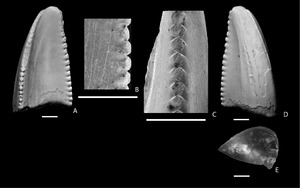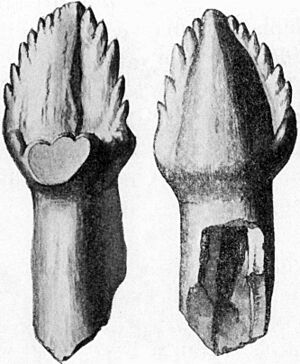Denticle (teeth) facts for kids


Denticles are tiny, sharp bumps found on the edges of some animal teeth. You can think of them like the serrations on a steak knife, which help the knife cut through food more easily. These small bumps give a tooth a rough, saw-like edge, making it much better at cutting, tearing, or crushing food.
In paleontology, which is the study of ancient life, denticles are super important! Scientists often use the unique shapes and sizes of these tiny bumps to figure out what kind of dinosaur a fossilized tooth belonged to. They can even learn what the dinosaur likely ate, whether it was a meat-eater or a plant-eater.
Denticles aren't just found on dinosaur teeth. You can also see them on the teeth of some modern animals, like certain lizards, many sharks, and even some mammals.
Contents
What Are Denticles?
Denticles are small, pointed parts that stick out from the main body of a tooth. They are usually found along the cutting edges, also known as the carinae, of a tooth. These tiny structures are made of the same hard material as the rest of the tooth, like enamel or dentin. Their main job is to create a rough surface that can grip and slice through food more effectively.
Imagine trying to cut a tough piece of meat with a smooth knife. It would be hard, right? Now imagine using a knife with a serrated edge. Much easier! That's exactly how denticles help animals eat. They act like tiny saws, allowing teeth to cut through tough materials like skin, muscle, or tough plant fibers.
Why Do Teeth Have Denticles?
The main reason teeth have denticles is to improve their cutting and tearing ability. Different animals have different types of denticles depending on their diet. For example, a meat-eating animal needs teeth that can slice through flesh, while a plant-eating animal might need teeth that can grind tough leaves and stems.
- For Meat-Eaters: Denticles help teeth act like scissors, allowing them to shear through muscle and bone. This makes it easier for predators to quickly tear apart their prey.
- For Plant-Eaters: Some plant-eaters also have denticles, but they might be shaped differently. They can help grind down tough plant material, breaking it into smaller pieces that are easier to digest.
Denticles in Dinosaurs
Dinosaur teeth are famous for their denticles, and studying them has taught us a lot about these ancient creatures. The size, shape, and number of denticles on a dinosaur tooth can tell paleontologists a lot about its diet and how it lived.
Meat-Eaters' Teeth
Many theropod dinosaurs, like the mighty Tyrannosaurus rex and Velociraptor, had teeth with very clear denticles. These teeth were often long, curved, and blade-like, perfect for tearing into flesh.
- Tyrannosaurus rex: T. rex had banana-shaped teeth with strong, deep denticles. These weren't just for slicing; they were also strong enough to crush bone. The denticles helped the tooth grip and rip through the tough hides of its prey.
- Dromaeosaurs: Dinosaurs like Velociraptor and Deinonychus had thinner, more blade-like teeth with smaller, very sharp denticles. These teeth were excellent for slicing and tearing, much like a modern-day shark's teeth.
Plant-Eaters' Teeth
While meat-eaters often had the most obvious denticles, some plant-eating dinosaurs also had them. However, their denticles were usually shaped differently, designed for grinding rather than slicing.
- Hadrosaurs: These "duck-billed" dinosaurs had hundreds of teeth packed together in their jaws, forming a large grinding surface. Each tooth had small, ridged denticles that helped them chew and process tough plant material.
- Ankylosaurus: This armored dinosaur had small, leaf-shaped teeth with denticles that looked more like tiny bumps or ridges. These were perfect for stripping leaves from plants and grinding them down.
Denticles in Other Animals
Denticles are not unique to dinosaurs. Many animals alive today also have them, showing how useful these tooth features are for different diets.
- Sharks: Most sharks have multiple rows of sharp teeth, and many of these teeth have very distinct denticles. These serrations help sharks slice through the flesh of their prey, making them incredibly efficient predators. When a shark loses a tooth, another one quickly moves forward to replace it.
- Lizards: Some lizards, especially those that eat insects or small animals, have teeth with small denticles. These help them grip and break down their food.
- Mammals: While not as common or as pronounced as in sharks or dinosaurs, some mammals also have teeth with features that act like denticles. For example, the molars of some meat-eating mammals have sharp cusps and ridges that help shear meat, similar to how denticles work.
How Scientists Study Denticles
Paleontologists use special tools and techniques to study denticles on fossilized teeth. They might use powerful microscopes to examine the tiny bumps up close. By looking at the pattern, size, and shape of the denticles, they can often identify the exact species of dinosaur or ancient animal the tooth belonged to.
Sometimes, scientists even make detailed 3D scans of fossil teeth. These scans allow them to create digital models that can be studied from every angle. By comparing the denticles on fossil teeth to those of modern animals with known diets, scientists can make educated guesses about what ancient creatures ate. This helps us understand the food webs and ecosystems of millions of years ago.

